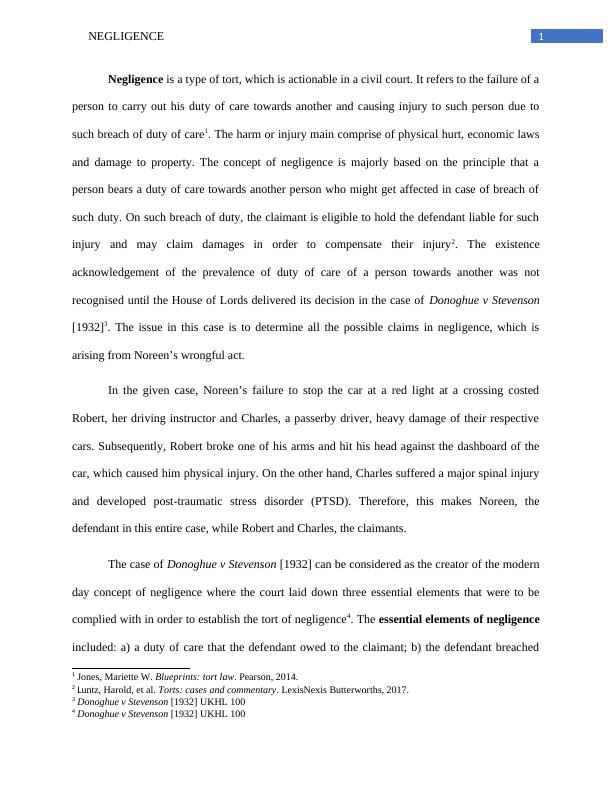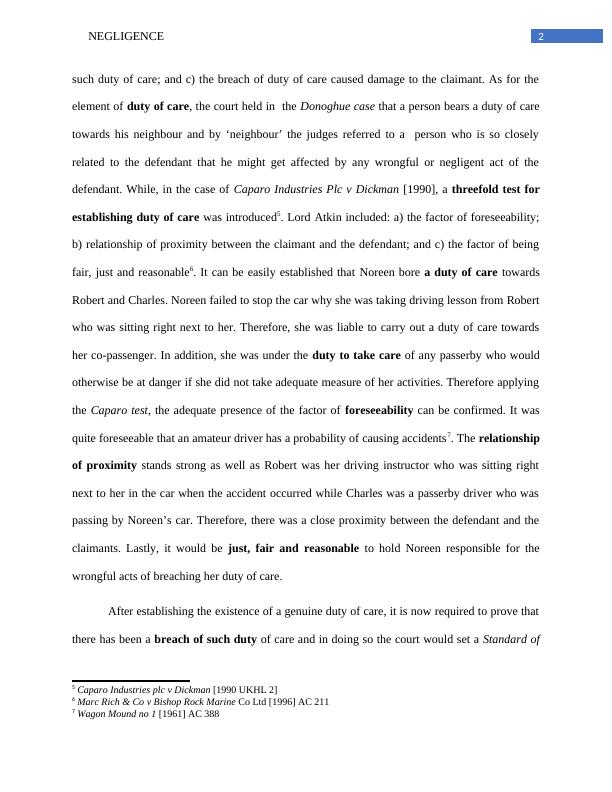Negligence in Tort Law: Elements, Standards, and Damages
Added on 2023-04-22
6 Pages1862 Words296 Views
Running head: NEGLIGENCE
Negligence
Name of the student
Name of the University
Author Note
Negligence
Name of the student
Name of the University
Author Note

1NEGLIGENCE
Negligence is a type of tort, which is actionable in a civil court. It refers to the failure of a
person to carry out his duty of care towards another and causing injury to such person due to
such breach of duty of care1. The harm or injury main comprise of physical hurt, economic laws
and damage to property. The concept of negligence is majorly based on the principle that a
person bears a duty of care towards another person who might get affected in case of breach of
such duty. On such breach of duty, the claimant is eligible to hold the defendant liable for such
injury and may claim damages in order to compensate their injury2. The existence
acknowledgement of the prevalence of duty of care of a person towards another was not
recognised until the House of Lords delivered its decision in the case of Donoghue v Stevenson
[1932]3. The issue in this case is to determine all the possible claims in negligence, which is
arising from Noreen’s wrongful act.
In the given case, Noreen’s failure to stop the car at a red light at a crossing costed
Robert, her driving instructor and Charles, a passerby driver, heavy damage of their respective
cars. Subsequently, Robert broke one of his arms and hit his head against the dashboard of the
car, which caused him physical injury. On the other hand, Charles suffered a major spinal injury
and developed post-traumatic stress disorder (PTSD). Therefore, this makes Noreen, the
defendant in this entire case, while Robert and Charles, the claimants.
The case of Donoghue v Stevenson [1932] can be considered as the creator of the modern
day concept of negligence where the court laid down three essential elements that were to be
complied with in order to establish the tort of negligence4. The essential elements of negligence
included: a) a duty of care that the defendant owed to the claimant; b) the defendant breached
1 Jones, Mariette W. Blueprints: tort law. Pearson, 2014.
2 Luntz, Harold, et al. Torts: cases and commentary. LexisNexis Butterworths, 2017.
3 Donoghue v Stevenson [1932] UKHL 100
4 Donoghue v Stevenson [1932] UKHL 100
Negligence is a type of tort, which is actionable in a civil court. It refers to the failure of a
person to carry out his duty of care towards another and causing injury to such person due to
such breach of duty of care1. The harm or injury main comprise of physical hurt, economic laws
and damage to property. The concept of negligence is majorly based on the principle that a
person bears a duty of care towards another person who might get affected in case of breach of
such duty. On such breach of duty, the claimant is eligible to hold the defendant liable for such
injury and may claim damages in order to compensate their injury2. The existence
acknowledgement of the prevalence of duty of care of a person towards another was not
recognised until the House of Lords delivered its decision in the case of Donoghue v Stevenson
[1932]3. The issue in this case is to determine all the possible claims in negligence, which is
arising from Noreen’s wrongful act.
In the given case, Noreen’s failure to stop the car at a red light at a crossing costed
Robert, her driving instructor and Charles, a passerby driver, heavy damage of their respective
cars. Subsequently, Robert broke one of his arms and hit his head against the dashboard of the
car, which caused him physical injury. On the other hand, Charles suffered a major spinal injury
and developed post-traumatic stress disorder (PTSD). Therefore, this makes Noreen, the
defendant in this entire case, while Robert and Charles, the claimants.
The case of Donoghue v Stevenson [1932] can be considered as the creator of the modern
day concept of negligence where the court laid down three essential elements that were to be
complied with in order to establish the tort of negligence4. The essential elements of negligence
included: a) a duty of care that the defendant owed to the claimant; b) the defendant breached
1 Jones, Mariette W. Blueprints: tort law. Pearson, 2014.
2 Luntz, Harold, et al. Torts: cases and commentary. LexisNexis Butterworths, 2017.
3 Donoghue v Stevenson [1932] UKHL 100
4 Donoghue v Stevenson [1932] UKHL 100

2NEGLIGENCE
such duty of care; and c) the breach of duty of care caused damage to the claimant. As for the
element of duty of care, the court held in the Donoghue case that a person bears a duty of care
towards his neighbour and by ‘neighbour’ the judges referred to a person who is so closely
related to the defendant that he might get affected by any wrongful or negligent act of the
defendant. While, in the case of Caparo Industries Plc v Dickman [1990], a threefold test for
establishing duty of care was introduced5. Lord Atkin included: a) the factor of foreseeability;
b) relationship of proximity between the claimant and the defendant; and c) the factor of being
fair, just and reasonable6. It can be easily established that Noreen bore a duty of care towards
Robert and Charles. Noreen failed to stop the car why she was taking driving lesson from Robert
who was sitting right next to her. Therefore, she was liable to carry out a duty of care towards
her co-passenger. In addition, she was under the duty to take care of any passerby who would
otherwise be at danger if she did not take adequate measure of her activities. Therefore applying
the Caparo test, the adequate presence of the factor of foreseeability can be confirmed. It was
quite foreseeable that an amateur driver has a probability of causing accidents7. The relationship
of proximity stands strong as well as Robert was her driving instructor who was sitting right
next to her in the car when the accident occurred while Charles was a passerby driver who was
passing by Noreen’s car. Therefore, there was a close proximity between the defendant and the
claimants. Lastly, it would be just, fair and reasonable to hold Noreen responsible for the
wrongful acts of breaching her duty of care.
After establishing the existence of a genuine duty of care, it is now required to prove that
there has been a breach of such duty of care and in doing so the court would set a Standard of
5 Caparo Industries plc v Dickman [1990 UKHL 2]
6 Marc Rich & Co v Bishop Rock Marine Co Ltd [1996] AC 211
7 Wagon Mound no 1 [1961] AC 388
such duty of care; and c) the breach of duty of care caused damage to the claimant. As for the
element of duty of care, the court held in the Donoghue case that a person bears a duty of care
towards his neighbour and by ‘neighbour’ the judges referred to a person who is so closely
related to the defendant that he might get affected by any wrongful or negligent act of the
defendant. While, in the case of Caparo Industries Plc v Dickman [1990], a threefold test for
establishing duty of care was introduced5. Lord Atkin included: a) the factor of foreseeability;
b) relationship of proximity between the claimant and the defendant; and c) the factor of being
fair, just and reasonable6. It can be easily established that Noreen bore a duty of care towards
Robert and Charles. Noreen failed to stop the car why she was taking driving lesson from Robert
who was sitting right next to her. Therefore, she was liable to carry out a duty of care towards
her co-passenger. In addition, she was under the duty to take care of any passerby who would
otherwise be at danger if she did not take adequate measure of her activities. Therefore applying
the Caparo test, the adequate presence of the factor of foreseeability can be confirmed. It was
quite foreseeable that an amateur driver has a probability of causing accidents7. The relationship
of proximity stands strong as well as Robert was her driving instructor who was sitting right
next to her in the car when the accident occurred while Charles was a passerby driver who was
passing by Noreen’s car. Therefore, there was a close proximity between the defendant and the
claimants. Lastly, it would be just, fair and reasonable to hold Noreen responsible for the
wrongful acts of breaching her duty of care.
After establishing the existence of a genuine duty of care, it is now required to prove that
there has been a breach of such duty of care and in doing so the court would set a Standard of
5 Caparo Industries plc v Dickman [1990 UKHL 2]
6 Marc Rich & Co v Bishop Rock Marine Co Ltd [1996] AC 211
7 Wagon Mound no 1 [1961] AC 388

End of preview
Want to access all the pages? Upload your documents or become a member.
Related Documents
Role of Foresight in the Neighbour Principle in Modern Negligence Lawlg...
|10
|3885
|439
Business Law: Negligence and Recovery of Economic Losslg...
|6
|1050
|191
Law of Torts: Rights of Gina and Samuellg...
|14
|3628
|192
Tort Law: Establishing Negligence and Defense of Volenti Non Fit Injurialg...
|9
|2482
|62
Case Study Assignment on Tort of Negligence and Australian Consumer Lawlg...
|11
|3022
|114
Can Cliff and Mary sue Susan for negligence?lg...
|7
|2387
|124
